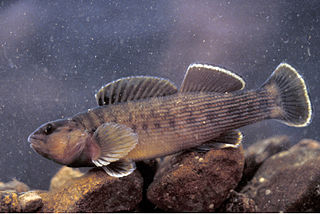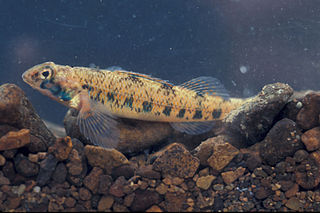
The snail darter is a small species of freshwater ray-finned fish, a darter from the subfamily Etheostomatinae, part of the family Percidae, which also contains the perches, ruffes and pikeperches. It is found in East Tennessee freshwater in the United States and in small portions of northern Alabama and Georgia. First recorded in 1973, the snail darter was listed as endangered under the U.S. Endangered Species Act of 1973 by 1975. The species was at the center of a major environmental law controversy that involved a lawsuit seeking to halt the completion of Tellico Dam, which posed a risk of extinction for the snail darter by blocking its migratory route. The case was eventually appealed to the U.S. Supreme Court, which ruled on it in its 1978 decision Tennessee Valley Authority v. Hill.
The Bayou darter is a rare species of freshwater ray-finned fish, a darter from the subfamily Etheostomatinae, part of the family Percidae, which also contains the perches, ruffes and pikeperches. It is endemic to western Mississippi in the United States, where it is found only in Bayou Pierre and its tributaries. Its typical habitat is fast-flowing creeks and streams, in riffles and in areas between riffles with firm gravel bottoms. It feeds on small insects and their larvae. Breeding probably takes place twice a year, in spring and late summer. The population of this fish is declining due to loss of suitable habitat. This is caused by siltation and pollution, particularly erosion caused by changes in land use. The International Union for Conservation of Nature has assessed its conservation status as being "endangered".

The trispot darter is a species of freshwater ray-finned fish, a darter from the subfamily Etheostomatinae, part of the family Percidae, which also contains the perches, ruffes and pikeperches. It is endemic to northern Georgia and southern Tennessee in the United States, where it occurs in the Conasauga River and its tributaries and historically in the Alabama River system. It requires two interconnecting habitats; outside the breeding season it occupies the peripheral zones of the main river, with slow-moving water and silt gravel substrates with vegetation cover; during the breeding season it moves to warmer water with a clay-bottomed substrate with much vegetation. The population of this fish is declining due to loss of suitable habitat because of stream impoundment and land development. The International Union for Conservation of Nature has assessed its conservation status as being "vulnerable".

The dusky darter is a species of freshwater ray-finned fish, a darter from the subfamily Etheostomatinae, part of the family Percidae, which also contains the perches, ruffes and pikeperches. It is found in, but not confined to, both large and small rivers, and shallow creeks, in the eastern, southern, and southeastern United States, particularly the Mississippi River drainage system.
The Cumberland snubnose darter is a species of freshwater ray-finned fish, a darter from the subfamily Etheostomatinae, part of the family Percidae, which also contains the perches, ruffes and pikeperches. This species is found in the middle Cumberland River drainage in Tennessee, Kentucky, Virginia, North Carolina, Georgia, and Alabama. It is absent in reaches above the Big South Fork, rare in North Carolina, and absent in western tributaries of the Tennessee River. While research on the ecology of E. atripinne is not extensive, what is known is they are usually found in small to medium freshwater streams in gravel riffle areas where their eggs can attach to the substrate and be left unguarded. E. atripinne can be found within a wide range of depths in its environment, leading its being classified as benthopelagic. While its global status is secure, the American Fisheries Society labels it with a status of “Special Concern”.
The emerald darter, is a species of freshwater ray-finned fish, a darter from the subfamily Etheostomatinae, part of the family Percidae, which also contains the perches, ruffes and pikeperches. It is found only in northern and eastern Kentucky and northeastern Tennessee.
The corrugated darter is a species of freshwater ray-finned fish, a darter from the subfamily Etheostomatinae, part of the family Percidae, which also contains the perches, ruffes and pikeperches. It is endemic to the eastern United States only known from Caney Fork, Tennessee, where it has been shown to have as many as five subgroups. They are active hunters which prey on insects, fry, and possibly young snails. Multiple species and subspecies of these darters can coexist where substrate is varied, so this must be carefully preserved to accommodate many similar species. With the warming of spring, E. basilare enters its breeding cycle and males develop their dimorphic coloration. Like most darters, it hugs the stream bed, using its body shape and fin posture to maintain its position.

The orangefin darter is a species of freshwater ray-finned fish, a darter from the subfamily Etheostomatinae, part of the family Percidae, which also contains the perches, ruffes and pikeperches. It is found in Barren River and Green River systems in Tennessee and Kentucky.

The bluebreast darter is a small species of freshwater ray-finned fish, a darter from the subfamily Etheostomatinae, part of the family Percidae, which also contains the perches, ruffes and pikeperches. It is endemic to the eastern United States from New York and Illinois to Tennessee and North Carolina.
The stone darter is a species of freshwater ray-finned fish, a darter from the subfamily Etheostomatinae, part of the family Percidae, which also contains the perches, ruffes and pikeperches. It is endemic to the eastern United States.
The cherry darter is a species of freshwater ray-finned fish, a darter from the subfamily Etheostomatinae, part of the family Percidae, which also contains the perches, ruffes and pikeperches. It is endemic to the upper Caney Fork system of the Cumberland River drainage in the U.S. state of Tennessee.

The blueside darter is usually found in the Tennessee River drainage in Tennessee, Alabama, North Carolina, and Virginia, and less commonly found in Bear Creek, Shoal Creek, and Barren Fork.
The stripetail darter is a species of freshwater ray-finned fish, a darter from the subfamily Etheostomatinae, part of the family Percidae, which also contains the perches, ruffes and pikeperches. It is endemic to the eastern United States. It is found in small rivers and streams in the states of Tennessee, Ohio, Kentucky, Illinois, Alabama, Georgia, and Mississippi. Males are a golden-orange color with black barring on the fins, and grow to a length of about 2.8 in (7 cm). This fish feeds on midge larvae and other small invertebrates. It breeds in the spring; eggs are attached to the substrate, often under slab rocks, where they are guarded by the male. The population trend of this fish seems to be stable and it is a common species with numerous sub-populations over a wide range, and the International Union for Conservation of Nature has assessed its conservation status as being of "least concern".
The goldstripe darter is a species of freshwater ray-finned fish, a darter from the subfamily Etheostomatinae, part of the family Percidae, which also contains the perches, ruffes and pikeperches. It is endemic to the southeastern United States where it is found in Gulf Slope streams from the Colorado River drainage in Texas to the Flint River in Georgia, the Atlantic Slope in Ocmulgee River system, Georgia, and the Mississippi embayment north as far as southeastern Missouri and western Kentucky. It is typically found in small springs, streams, and creeks with aquatic and marginal vegetation and detritus. The female spawns on multiple occasions between about mid-March and June, sticking the adhesive eggs to plants, gravel and the sides of rocks. The goldstripe darter is a common species with a wide range and numerous sub-populations, and the International Union for Conservation of Nature has assessed its conservation status as being of "least concern".

The orangethroat darter is a species of freshwater ray-finned fish, a darter from the subfamily Etheostomatinae, part of the family Percidae, which also contains the perches, ruffes and pikeperches. It is endemic to the central and eastern United States where it is native to parts of the Mississippi River Basin and Lake Erie Basin. Its typical habitat includes shallow gravel riffles in cooler streams and rocky runs and pools in headwaters, creeks, and small rivers, with sand, gravel, rubble, or rock substrates. It forages on the bottom for the aquatic larvae of midges, blackfly, mayfly and caddisfly, as well as isopods and amphipods. Spawning takes place in spring, the selected sites often being the upper stretches of riffles with sandy and gravelly bottoms interspersed with larger cobble. Reproductive success is high in this species. No particular threats have been identified, and the International Union for Conservation of Nature has assessed its conservation status as being of "least concern".

The blackbanded darter is a species of freshwater ray-finned fish, a darter from the subfamily Etheostomatinae, part of the family Percidae, which also contains the perches, ruffes and pikeperches. It is native to the river systems of the southeastern United States where it is found in the states of Tennessee, Georgia, Florida, Mississippi, Alabama, and Louisiana. It lives over sandy or gravelly bottoms in smaller rivers and streams and its color varies depending on the different habitats in which it lives. It feeds on small insect larvae and is itself preyed on by larger fish. It spawns between February and June depending on locality. It is generally a common fish throughout most of its range.

The Cherokee darter is a rare species of freshwater ray-finned fish, a darter from the subfamily Etheostomatinae, part of the family Percidae, which also contains the perches, ruffes and pikeperches. It is endemic to Georgia in the United States, where it is limited to the Etowah River system. It inhabits creeks with rocky bottoms and little silt, typically occurring just above and below riffles. It is a whitish or yellowish fish with green and black spots on the flanks and eight dark saddle-like bars dorsally. It has a small range and its habitat is being degraded and fragmented, and the International Union for Conservation of Nature has assessed its conservation status as being endangered.

The relict darter is a rare species of freshwater ray-finned fish, a darter from the subfamily Etheostomatinae, part of the family Percidae, which also contains the perches, ruffes and pikeperches. It is endemic to Kentucky, where it occurs only in the drainage of the Bayou de Chien. It is a federally listed endangered species of the United States.
Etheostoma obama, the spangled darter, is a species of freshwater ray-finned fish, a darter from the subfamily Etheostomatinae, part of the family Percidae, which also contains the perches, ruffes and pikeperches. It is endemic to the eastern United States where it is only known to occur in the Duck River and the Buffalo River, both in Tennessee.
Nothonotus starnesi, the Caney Fork darter, is a species of freshwater ray-finned fish, a darter from the subfamily Etheostomatinae, part of the family Percidae, which also contains the perches, ruffes and pikeperches. It is endemic to Caney Creek in Tennessee. This species is found in small rivers where there are riffles with clear water and a gravel substrate. Its specific name honours the American ichthyologist Wayne C. Starnes of the North Carolina Museum of Natural Sciences.











